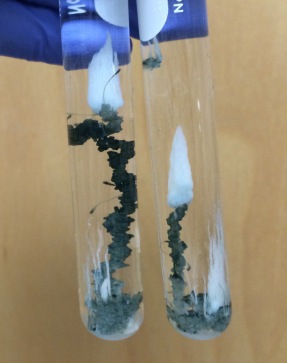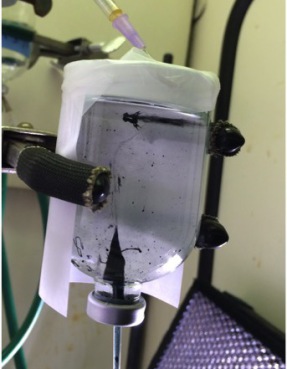Chemical Gardens and Hydrothermal Chimneys
Chemical gardens are plant-like structures that form spontaneously when two fluids containing reactive ions interface. We are interested in the physical and chemical mechanisms that control the formation of these self-organizing structures and patterns, which has relevance to materials science, similar mechanisms in biology and geology, and even the origin of life.
Hydrothermal chimneys grow at seafloor vents due to mineral precipitation between the contrasting seawater and vent fluid. These chimneys are an example of geological chemical gardens, and in natural systems they can grow quite quickly and reach very large sizes (the chimneys at the Lost City Hydrothermal Field, for example, are up to 60 meters tall). Hydrothermal chimneys are thought to have been important for prebiotic chemistry since they contain catalytic minerals, and are full of layers / pores / gels where reactions can occur and products can become concentrated.
Current funded projects in this theme include:
Habitability of Saponite-rich Hydrothermal Systems of Early Mars
NASA Habitable Worlds program; PI: Roy Price (SUNY Stony Brook), Co-I: Laurie Barge
The Strytan Hydrothermal Field (SHF) in Iceland is one of the only places on Earth where massive, hydrothermal saponite is being deposited in an alkaline hydrothermal environment, making it an ideal analog for similar clay-rich deposits on Mars. Our goals are to evaluate how saponite-rich chimneys like this could have supported biological processes on Mars or the early Earth. At JPL the students' work will focus on: exploring lab chimney formation under different conditions relevant to early Mars (including formation of Fe/Mg-silicates and clays), evaluating the electrical energy generated by laboratory simulated chimneys, and testing incorporation of organic matter in synthetic hydrothermal chimneys.
Habitability estimates for heterotrophic metabolisms in wet-to-dry transient environments on Noachian Mars (HabMars)
NASA Habitable Worlds program; PI: Roy Price (SUNY Stony Brook), Co-I: Laurie Barge
This project, also focusing on the SHF as an analog to environments on Mars, aims to improve understanding of potential heterotrophic metabolisms on early Mars, using studies of field samples and lab-created chimneys put under Mars conditions and analyzed with Mars-mission-relevant techniques.
Simulating the Emergence of Metabolism in an Alkaline Hydrothermal Vent
NASA Exobiology; PI: Laurie Barge (JPL); Co-I: John-Paul Jones (JPL), Collaborator: Pete Girguis (Harvard)
This project is to conduct laboratory tests of prebiotic chemistry in hydrothermal vent chimneys under deep-sea conditions relevant to early Earth. In this work we will grow chemical gardens of iron sulfides and hydroxides in a hydrothermal reactor capable of simulating hydrothermal chimney growth under high pressure (2,650 psi) and temperature (~100C). The chemical garden precipitates produced will be reacted with geological carbon sources (CO2 and CH4) to test whether organic molecules are produced.



